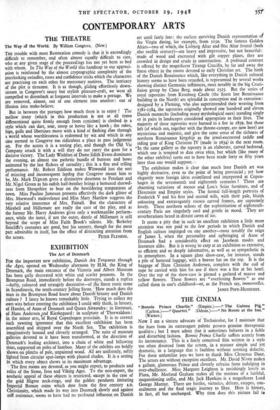EXHIBITION
The Art of Denmark FOR the important new exhibition, Danish Art Treasures through the Ages, opened on Wednesday afternoon by H.M. the King of Denmark, the main entrance of the Victoria and Albert Museum has been gaily decorated with white and scarlet pennons. In the Brompton Road, immediately before the doorways, stands a replica —hefty, coloured and strangely decorative—of the finest runic stone in Scandinavia, the tenth-century Jelling Stone. How much does the man in the Brompton Road know about Danish history and Danish culture ? I fancy he knows remarkably little. Trying to collect my own wits before entering the exhibition I could only think, in history, of Hamlet, of Anne of Denmark and Queen Alexandra: in literature, of Hans Andersen and Kierkegaard : in sculpture of Thorwaldsen: in the minor arts, of Royal Copenhagen porcelain. It is to correct such yawning ignorance that this excellent -exhibition has been assembled and shipped over the North Sea. The exhibition is imaginatively housed and cleverly arranged. The suite of museum galleries devoted to it have been transformed, at the direction of Denmark's leading architect, into a chain of white and billowing tents, supported on poles of bamboo. Many of the exhibits are boldly shown on plinths of pale, unpainted wood. All are uniformly, softly lighted from circular spot-lamps with pleated shades. It is a setting in which every object shows to its maximum advantage.
The first rooms are devoted, as you might expect, to products and relics of the Stone, Iron and Viking Ages. To the non-expert, the aesthetic appeal of these objects is restricted, except in the case of the gold filigree neck-rings, and the golden pendants imitating Imperial Roman coins which date from the first century A.D. Christianity, which made its way into Denmark slowly and against stiff resistance, seems to have had no profound influence on Danish art until fairly late : the earliest surviving Danish representation d the Virgin dating, for example, from 1150. The famous Golden Altars—two of which, the Lisbjerg Altar and Olst Altar frontal (both also twelfth century)—are heavy and impressive, but not beautiful : made of wood and encrusted with gilt copper plates, they are crowded in design and crude in construction. A profound contrast is offered by the magnificent Tirstup Crucifix, by far and away the finest object in the rooms devoted to early Christian art. The birth of the Danish Renaissance which, like everything in Danish cultural history seems to have been retarded, is represented by several works showing distinct Germanic influences, most notably in the big Cruci- fixion group by Claus Berg, made about 1525. But the series of royal tapestries from Kronborg Castle (the finest late Renaissance building in the North) are splendid in conception and in execution: designed by a Fleming, who also superintended their weaving from 1581-1584, the tapestries originally showed one hundred and eleven Danish monarchs (including many mythological ones) standing singly or in pairs in landscapes considered appropriate to their lives. The majority of these tapestries were burned in a fire in 1859, but those left (of which ten, together with the throne-canopy, are now here) are mysterious and majestic, and give the same sense of the richness of northern Renaissance kingship as the jewel-encrusted saddle and riding gear of King Christian IV (made in 1634) in the next room. ^In the same gallery as the tapestry is an elaborate, carved bedstead, which one is tempted to date circa x6io, but which (like many of the other exhibits) turns out to have been made forty or fifty years later than one would suppose.
The exhibition makes it clear that much later Danish art was highly derivative, even to the point of being provincial ; yet how elegantly were foreign ideas assimilated and interpreted at Copen- hagen in the seventeenth and eighteenth centuries ! There are charming variations of rococo and Lou:s Seize furniture, and of Directoire and Empire styles. The formal full-length portraits of Frederick V and his first and second wife, with their pale, bluish colouring and extravagantly rococo carved frames, are supremely lovely. These northern echoes of the sophistication of eighteenth- century Paris are singularly cool and gentle in mood. They are reverberations heard in distant caves of ice.
It seems a pity that in such an excellent exhibition a little more attention was not paid to the few periods in which Danish and English culture impinged on one another—most notably the reign of James I, when the personality and upbringing of Anne of Denmark had a considerable effect on Jacobean modes and literature alike. But it is wrong to carp at an exhibition so extensive, so efficient and so deeply informative, as well as so sympathetic in its atmosphere. In a square glass show-case, for instance, stands a pile of battered luggage, with a beaver hat on the top. It is the baggage of Hans Christian Andersen, complete with the coil of rope he carried with him for use if there was a fire at his hotel. Over the top of the show-case is pinned a garland of mauve and yellow flowers. These flowers are "everlasting flowers" as one called them in one's childhood—or, as the French say, immortelles.
JAMES POPE-HENNESSY.


































 Previous page
Previous page